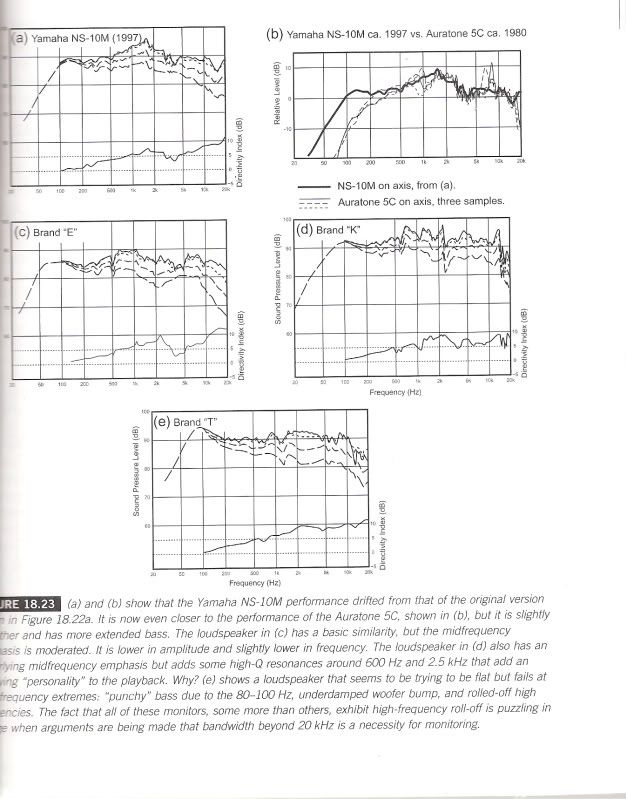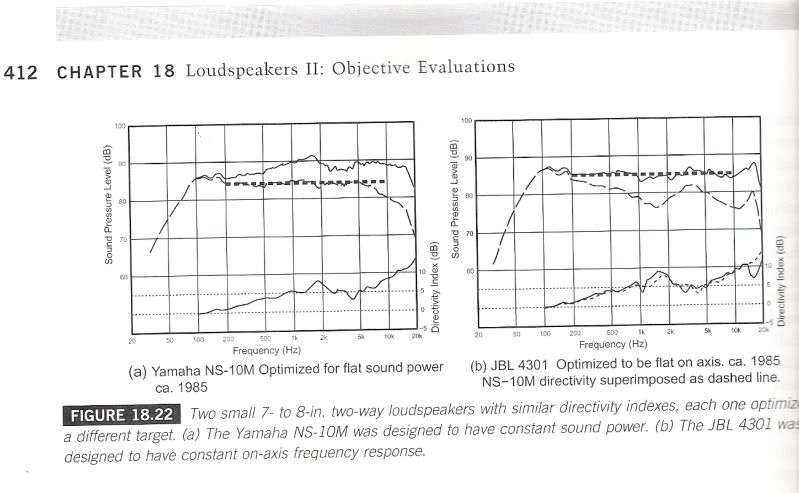but if you average them you will see a clear tendency to a flat frequency response
Do you have some statistics to back up your claim? Because that isn't what I see in mediocre home speakers I see a decided average of both low and high frequency response, and a decided emphasis in the mid range: In other words, mediocre speakers just plain sound "honky", not flat.
there is no universal bad sounding monitor to be a reference
Except for the NS-10, of course!

the ns 10m has basically the same freq response as the auratone 5c with a little more bass
Sorry, but I have to hugely disagree with that. They aren't even close. See below.
ns-10 and ns10m are far from flat in freq response but thy are flat in sound power
No they are not. See below.
FR-NS-10.jpg
FR-AURATONE.jpg
Neither the NS10M nor the Auratone is flat in sound power, frequency response, or harmonics.
There's a good reason that the old Auratones quickly lost favor and were replaced by NS10's The Auratones sounded crappy, and the NS10's didn't! The response curves show part of that picture, but there are other major reasons to.
NS10's didn't become popular because everyone thought that Bob Clearmountain was a guru to be imitated, no matter what. Other engineers had ears and brains too. Bob was just lucky enough to find the NS10's first.
Despite popular legend, NS10's didn't just become popular because one big-name engineer used them. They became popular because many other engineers like them too! To claim otherwise is to suggest that all the other engineers had lousy hearing, no brains, couldn't tell the difference, and only used NS10s because "Bob uses them"! That's a pretty poor reflection of the other engineers.
The reason they tried out NS10's might well be "because Bob uses them", but the reason why they CONTINUED to use them, is because when the tried them, they found that Bob was right! NS10's really were better than what they had before, and were actually pretty good at exposing problems in a mix.
Compare the above curves with a couple of decent more modern speakers that actually do have pretty flat response curves that actually are similar:
FR-MACKIE-HR824.jpg
FR-STUDER-A5.jpg
ns-10 are bad speaker and should not be a reference
So you are saying that all the great engineers over the past few decades that swore by NS10's, used them day-in and day-out, and turned out numerous fantastic mixes four countless hit albums, were all idiots? That the weren't smart enough to figure out that, in realty, Bob was an idiot and they were lousy monitors? Sorry, but once again I disagree.
NS10s may be mediocre by today's standards, but compared to what was available back then when they became popular, they are pretty darn good. The response curve might not look like much, but it turns out to be a great curve for doing good mixes on, because it exposes issues harshly: It doesn't just "tell the the truth" like a monitor with a flat curve does, but actually "yells and screams the truth", precisely BECAUSE the curve is not flat. If you listen to an NS10 and get a good sounding mix on it, you find that you just automatically compensate for the mid-range emphasis by reducing your mix in those areas, boosting the lows a lot and the highs a little, and ... oh Gee! ... Hot Damn! .... That would mean that you
approximated a loudness curve!!!!
As it turns out, the NS10 frequency curve is a pretty good mirror image facsimile of an 80 or 90-phon Fletcher-Munsen curve!!! Coincidence?

Hardly!
Basically, the NS10 forces you to subconsciously do a mix that lacks mids and boosts highs and lows, and ends up looking like a curve that the human ear finds pleasant to listen to! Surprise!
It doesn't sound like a good speaker, but it forces you to produces mixes that sound good to the human ear! Not a coincidence at all. It became popular among engineers because it helped them to do mixes that sound great and translate well.
The NS10 also has great phase timing across the low end, because it is NOT a ported design. If it had ben ported, the bass response would have been better but the bass timing would have been lousy. So the bass and kick sit together well, and you can judge them truthfully, whereas ported designs tend to screw up the timing and phasing of lows, making it harder to get the low end tight.
There are many characteristics of the NS10 that one might question, but it most certainly isn't a "bad speaker that should not be a reference", which is what you suggested! Making such a claim questions the intelligence, skills, hearing and integrity of numerous engineers who used them to turn out some of the best music ever, in years gone by. And the folks who still use them today.
became a standard because thy attributed the sound of a great engineer to the speakers he used and that is so wrong in so many levels.
No, there is nothing "wrong" with seeing what some other guys uses, and trying it out for yourself. On the contrary, I'd say that it would be "wrong" to
ignore what big-name engineers and artists do and don't use! Once again, to say that people ONLY used NS10's because the thought that was Bob Clearmountain's secret to success, is to question the intelligence and listening skills of countless other good engineers. Sure, Bob used them first, others noticed what he was doing and tried them out to, but you can bet that if they had not LIKED what they heard, and had not been able to produce mixes that were BETTER than what they had produced before, then they wold not have continued to use them. Suggesting otherwise questions the abilities of engineers around the world to judge for themselves whether or not a speaker is any good for mixing on.
Obviously, there probably were a few lousy engineers that used them ONLY because "that's what Bob uses", (just like there are lots of engineers today that use ProoTool because "that's what the big guys use"), but you can bet that the vast majority adopted NS10's for the same reason Bob did: because the NS10's allowed them to turn out consistently great mixes that translated well. Period.
dispersion from speakers vary a great deal especially when they are bad speakers good speaker tend to have very good dispersion that resemble the on axis
Yep. Which has nothing at all to do with what I said. It looks like you missed the point!
What I said was that the best point to listen to a speaker is NOT on axis, but at a point about 20° to 30° OFF axis, because that will tell you how good the dispersion is! Pretty much any half-decent speaker sounds good directly on axis, but it takes a great speaker to continue to sound just as good 30° off axis. But since we mixing folk DO tend to move around a lot in front of our consoles / DAWs, the zone around 20° to 30° off axis is where we do a lot of our hearing. You only need to move your chair (or head) a few inches to get off axis. Unless you bolt your head into a frame located exactly at the sweet spot, then on-axis response is meaningless.
So, once again, I repeat: "Actually, a point about 20% to 30% off-axis is the best place to get an idea of how a speaker really sounds, and how good its response is". Measuring on-axis doesn't tell you much about the speaker, except the basics. Measuring off axis tells you a lot more about it. If it is bad on-axis, it will be really terrible at 30°, so save yourself some time and just listen at 30° first. If it can still produce the exact same sound 30° off axis as it does on axis, then I'd call it a good speaker. Especially since my ears will most likely be spending a lot more time off-axis than they will on-axis.
Off-axis is what really matters in the real world, not on-axis.
- Stuart -


